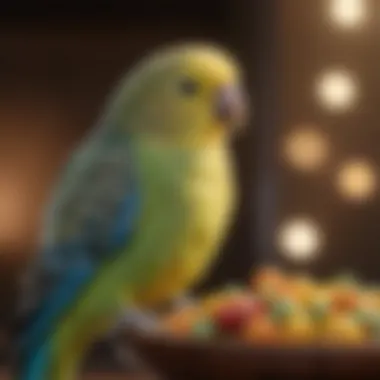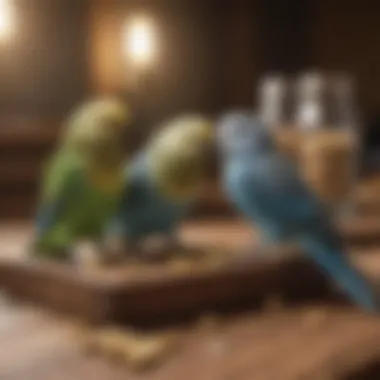Understanding and Choosing the Best Budgie Treats


Intro
Choosing the right treats for your budgie is a crucial aspect of their overall health and happiness. Understanding their needs and preferences can seem overwhelming, but this guide simplifies the process. With careful selection of suitable treats, budgie owners can enhance their pets' diet while offering variety and enjoyment. This article delves into the nutritional aspects, different types of treats available, and how to make informed choices for your feathered companions.
Understanding Your Pet
Pet Behavior Basics
To select the best treats for your budgie, recognizing their natural behaviors is essential. Budgies are social, curious birds known for their playful nature. Observing how they interact with their environment helps in understanding what types of treats will engage them. Some budgies may prefer crunchy snacks, while others are more attracted to softer options.
Common Breed Characteristics
Budgies come in various colors and patterns, but all share similar dietary requirements. Generally, they thrive on a balanced diet that includes seeds, pellets, fresh fruits, and vegetables. Treats should complement this base diet and not replace essential nutrients. Additionally, the personality of your budgie may influence treat selection. Some enjoy foraging, which makes seed sticks or mixed treat blends ideal.
Species-Specific Needs
Understanding the specific needs of budgies is vital. They require high levels of vitamin A, calcium, and a mix of proteins and carbohydrates. Treats can play a role in providing these nutrients. Opt for options that align with their dietary needs. Look for products specifically designed for budgies, as these typically account for their special requirements. Homemade treats can also cater to specific nutritional goals and offer an alternative to commercial products.
Pet Care and Maintenance
Feeding Guidelines
When choosing budgie treats, it's important to stick to feeding guidelines. Treats should comprise no more than 10% of their daily intake. Besides offering nutritional value, this limitation prevents the risk of obesity and related health issues.
Grooming Essentials
Grooming influences your budgie's health as well. Regular checks of their feathers and feet can help you identify issues early. Although treats are not directly related to grooming, healthy budgies with good diets are likely to maintain better feather quality.
Hygiene Practices
Maintaining a clean environment is essential for your budgie's well-being. Leftover crumbs from treats can accumulate bacteria and cause health issues. Regular cleaning of their cage, including food and water containers, protects them from potential infections.
Training and Development
Basic Commands and Skills
Training can also be enriched through treats. Positive reinforcement is a proven method that utilizes treats to encourage the learning of basic commands. Simple skills, like stepping onto a perch, can be taught using favorite treats as motivation.
Behavioral Training Techniques
Understanding your budgie's behavior is crucial for effective training. If a budgie exhibits unwanted behavior, such as excessive screaming, targeted treat training can redirect that energy positively. Tracking progress and offering treats when they exhibit desirable behavior reinforces learning.
Addressing Common Behavior Issues
Treats can play a role in addressing common issues, such as fear of new environments or objects. Gradually introducing new elements with treats can help them feel more secure and encourage exploration.
Health and Wellness
Routine Vet Check-ups
Regular vet visits are crucial for identifying health issues early. These check-ups often include dietary assessments. Discuss treat options with your vet to ensure they align with your budgie's health needs.
Vaccination Needs
Budgies may require vaccinations depending on their exposure and environment. Keeping records of vaccinations and discussing dietary choices, including treats, can help your vet suggest suitable options.


Recognizing Signs of Illness
Increased or decreased interest in treats can sometimes be the first sign of illness. Owners should monitor their budgie’s eating habits closely and consult a vet if drastic changes occur. Knowledge of what constitutes normal behavior supports quicker identification of health problems.
Enrichment and Activities
Indoor vs.
Outdoor Activities
Both indoor and outdoor activities are important for budgie enrichment. Treats can be used during playtime, whether it's providing foraging challenges indoors or during outdoor excursions in a safe space. Engaging budgies physically and mentally supports their overall health.
Interactive Toys and Games
Incorporating treats into interactive toys can stimulate your budgie's mind. These toys can be filled with seeds or other preferred snacks, making them more interesting than plain toys. This approach appeals to their foraging instinct.
Socialization Opportunities
Budgies are social creatures that thrive on interaction. Offering treats during playtime or family gatherings can foster bonding, both with their owners and other birds. Socialization contributes to their mental well-being, reducing stress and anxiety.
A well-chosen treat not only provides enjoyment but also nutritional benefit.
The Role of Treats in Budgie Nutrition
Treats hold a significant place in the nutrition of budgies. When used wisely, they can enhance the overall health and happiness of these birds. Choosing the right treats can contribute to a balanced diet and establish a stronger bond between the owner and the pet. This section will delve into various aspects, from dietary needs to using treats as a training tool.
Understanding Budgie Dietary Needs
Budgies, like all pets, have specific dietary requirements. A well-rounded diet includes seeds, pellets, and fresh foods such as fruits and vegetables. Budgies need vitamins, minerals, proteins, and carbohydrates. While treats are a small part of their total intake, selecting nutritious options is essential. Treats should not replace essential food components but rather complement them.
When considering budgie dietary needs, remember to avoid high-fat and sugary treats. Also, not every fruit is suitable for budgies. For example, avocado should never be offered, as it is toxic to them. Instead, offer safe fruits like apples and berries in moderation. Keep in mind that fresh water must always be available, regardless of the treats provided.
The Function of Treats in Training and Bonding
Treats play a vital role in training and bonding with your budgie. They can serve as positive reinforcement during training sessions, helping to establish good behavior. When a budgie performs a desired behavior, offering a treat reinforces that action, making it more likely to be repeated. This approach works well for teaching commands or tricks.
Moreover, the act of giving a treat can enhance the emotional bond between the bird and the owner. The budgie learns to associate the owner with positive experiences, leading to increased trust. Such a connection is crucial for a happy and healthy pet. Establishing empathy and communication through treats can significantly improve the relationship.
Using treats wisely can transform the interaction between you and your budgie, promoting better health and companionship.
In summary, treats are more than just a snack for budgies. They are tools for nutrition, training, and nurturing the bond shared between pets and their owners. Understanding the dietary needs of budgies ensures that any treats given contribute positively to their health and well-being.
Types of Budgie Treats
Understanding the varieties of treats available for budgies is fundamental for their well-being and overall health. Each type of treat offers unique benefits and features that can enhance a budgie's diet. By knowing the differences between commercial, natural, seed-based, and homemade treats, pet owners can make informed choices that contribute to a balanced and enjoyable diet for their feathered companions.
Commercial Treats: Pros and Cons
Commercial treats come in many forms, including packaged seed mixes, pellet treats, and flavored options. The primary advantage of these treats is their convenience. Store-bought treats are readily available and often designed specifically for budgies, addressing some of their nutritional needs. Many commercial options also contain added vitamins and minerals.
However, there are drawbacks. Some products contain artificial flavors, preservatives, and additives that may not be beneficial. It is crucial to read labels thoroughly before purchasing. Not all brands prioritize quality ingredients, and some treats might contribute to health issues if over-consumed. Hence, while they can be a part of a budgie's diet, moderation and selection of high-quality options should be prioritized.
Natural Treats: Fruits and Vegetables
Natural treats, such as fresh fruits and vegetables, offer a plethora of vitamins and minerals. Budgies enjoy items like spinach, carrots, apples, and berries. These natural options can be more appealing to birds and often promote hydration due to their water content. Fresh produce provides vital nutrients that promote health and vitality.
Nevertheless, not all fruits and vegetables are safe for budgies. It is essential to research before offering new foods, as some may be toxic. Likewise, freshness is key, as spoiled produce can cause illness. Offering a variety of natural treats can help keep a budgie interested in their diet.


Seed-Based Treats: How to Choose
Seed-based treats are popular among budgies, primarily due to their natural instinct to forage for seeds. These treats often contain a mixture of seeds that provide essential fats and protein. When selecting seed-based options, it is vital to opt for high-quality blends that include various seed types, as well as additional nutrients.
Pet owners should avoid products that are primarily made of sunflower seeds. While these are somewhat favored by budgies, too much can lead to obesity and nutritional imbalance. A balanced blend that includes other grains and seeds can provide a more wholesome approach to a budgie’s diet.
Homemade Treat Ideas
Creating homemade treats can be an excellent way to provide fresh and nutritious options for budgies. Not only can it ensure that no harmful additives are included, but it also allows for customization based on the bird's preferences.
Simple Recipes
Simple recipes for homemade budgie treats can include items like millet sprays, baked vegetable mixes, or fruit kabobs. These options allow pet owners to cater to their budgie’s specific tastes. Additionally, using known ingredients means there is control over what the bird consumes, which is beneficial for health and nutrition. Simple recipes tend to be more popular as they require minimal ingredients and effort, leading to a rewarding experience for both the bird and owner.
Storage and Preservation
Storage and preservation of homemade treats are crucial to maintaining their freshness and nutritional value. Properly storing these treats in airtight containers can prevent spoilage and maintain their palatability. It's advisable to keep them in a cool, dry place away from direct sunlight. Homemade treats that contain fruits and vegetables should be consumed quickly or refrigerated to minimize waste and ensure safety. The unique aspect of handling homemade treats is that the owner can adjust recipes based on their budgie's dietary needs.
Assessing Treat Quality
Assessing the quality of budgie treats is a crucial aspect of responsible pet ownership. Not only does it impact the nutritional value of the treats, but it also plays a significant role in the overall health and well-being of your budgie. High-quality treats are essential for maintaining optimal health. Poor-quality options may lead to various health issues or dietary imbalances. Therefore, being vigilant about the quality of treats can help in promoting a longer, healthier life for your feathered friend.
Reading Labels: What to Look For
When selecting treats for your budgie, it is vital to pay close attention to the product labels. These labels provide significant insights into what you're actually feeding your pet. Here are a few key points to consider when reading through the labels:
- Ingredients List: The first item on the list should ideally be a specific food item, not a vague term like 'grains' or 'animal by-products'. Look for whole ingredients such as millet, oats, or fresh fruits.
- Nutritional Information: Check the guarantees for protein, fat, and fiber content. Budgies need a balanced diet, and quality treats should complement their main diet.
- Additives and Preservatives: Avoid treats with artificial colors, flavors, and preservatives. These can be harmful to a budgie’s health. Instead, seek natural alternatives.
- Expiration Date: Always check the expiration date to ensure freshness. Expired treats may lose nutritional value or even pose a risk of illness.
Understanding Ingredients: Natural vs Artificial
A clear understanding of ingredients can help owners distinguish between beneficial and detrimental options. Natural ingredients are typically more nutritious and safer for your budgie than artificial alternatives.
- Natural Ingredients: These include fruits, vegetables, seeds, and nuts. Look for products labeled as organic. They usually do not contain harmful pesticides or chemicals.
- Artificial Ingredients: These are man-made and often include synthetic flavors, colors, and preservatives. Such ingredients may lead to adverse health effects over time. They can disrupt normal digestion and even cause allergies.
When choosing budgie treats, consider selecting options that are minimally processed. The less processing, the better the quality tends to be. You’ll find that nature often provides the best choices for maintaining your budgie's health and wellbeing.
Safety Considerations When Offering Treats
The safety of budgie treats is crucial. Selection of treats should not be taken lightly. If budgies consume harmful substances, it can lead to serious health issues. Understanding which foods are unsafe and how to manage treats is essential for their wellbeing.
Identifying Unsafe Foods
Not all treats are suitable for budgies. Certain foods can be detrimental to their health. Below are some common foods to avoid:
- Avocado: Contains persin, which can be toxic to birds.
- Chocolate: Contains theobromine and caffeine, which are harmful.
- Caffeine: Any source, whether coffee or soda, is not safe.
- Alcohol: Even small amounts can be dangerous.
- Salty or Sugary Treats: High salt or sugar can lead to kidney problems or obesity.
- Onions and Garlic: Can cause digestive issues and anemia.
Each of these foods poses a unique risk. It is important to read labels carefully and be informed of any potential hazards. When in doubt, consult your veterinarian.
Portion Control to Prevent Obesity
Portion control is key when giving treats. Overindulgence can lead to obesity in budgies. These birds do not have the ability to self-regulate their food intake. Hence, a structured approach is needed. Here are some suggestions:
- Limit Frequency: Treats should not exceed 10-15% of their total diet.
- Measure Portions: Use a small scale or measuring spoon to control how much treat is given.
- Monitor Weight: Regularly check your budgie’s weight to detect any changes.
- Healthy Options: Choose low-calorie treats, such as fresh vegetables, in moderation.
Understanding the importance of portion control can prevent health issues. Regularity and restraint lead to a happier, healthier budgie.


Incorporating Treats into Daily Routine
In an effort to nurture your budgie's overall health and happiness, incorporating treats into their daily routine plays a vital role. Treats not only serve as a delightful indulgence but also significantly contribute to their emotional well-being and dietary variety. Balancing treats within their daily consumption can help prevent boredom, foster a stronger bond between pet and owner, and can even act as motivational tools during training.
Creating a Balanced Treat Schedule
When setting up a balanced treat schedule, consider a few key elements. First, think about the frequency and timing of treats. Giving treats at regular intervals can create a sense of anticipation and joy for your budgie. Aim for treats to be given in moderation, ensuring that they complement their essential diet of pellets and fresh foods. Some owners prefer to allocate specific days for treats, while others mix them into daily feedings in controlled amounts. This prevents overindulgence and ensures a sustained interest in their primary food sources.
You can categorize treats based on their nutritional value. For instance:
- High-Nutritional Treats: Such as fruits and vegetables, should be integrated regularly.
- Occasional Treats: More sugary options might be fewer.
Furthermore, monitoring your budgie’s response can help refine the schedule. If they seem uninterested, you may need to rotate the options or adjust the timing. Each bird is unique, and being adaptive is key.
Using Treats for Behavior Modification
Treats can function as powerful tools for behavior modification. When training your budgie, offering a treat as a reward can reinforce positive actions. For example, when your budgie performs a desired behavior, such as stepping onto your finger or learning a trick, immediately rewarding them with a treat can help strengthen the connection between the behavior and the reward. This method can create a more approachable interactive experience.
Incorporating treats for the purpose of behavior modification entails understanding the psychology of your budgie. It is essential to use treats they enjoy to maintain their engagement. It is advised to start training sessions in short bursts of time to avoid overwhelming them. Consistency will reinforce the behavior over time. Additionally, using varying types of rewards can keep the process interesting for your feathered friend. For example, you might use bits of fresh fruits on some days and seed-based treats on others.
Prioritize the quality of the treats you use; the more enticing they are, the more effective your training will be.
Consider keeping a record of the behaviors you are focusing on and note which treats seem to elicit the best responses. This can help refine approach over time, leading to better outcomes for both you and your budgie.
Monitoring Your Budgie's Health with Treats
Monitoring your budgie's health is essential, especially in relation to the treats you provide. Treats can enhance your bird's quality of life but also potentially lead to health issues if not managed properly. Understanding the impact of treats on diet, behavior, and overall well-being is critical for all budgie owners. This section will focus on identifying signs of overindulgence and adjusting treats based on health changes.
Signs of Overindulgence
Budgies, like many pets, may not regulate their treat intake effectively. As a responsible owner, it's important to be vigilant for signs of overindulgence. These signs include:
- Weight Gain: Sudden changes in weight can signal an unhealthy treat consumption. Monitoring your budgie’s weight regularly can help you catch these changes early.
- Lethargy: Reduced activity levels or excessive sleeping might indicate that your budgie is consuming too many treats.
- Feather Plucking: Stress or boredom, often fueled by poor diet, can lead to behavioral issues like feather plucking. A diet that is too high in treats may contribute to these behaviors.
- Digestive Issues: Diarrhea or changes in droppings can suggest that treats are not suitable. It’s important to observe your budgie’s droppings regularly for signs of gastrointestinal distress.
If you notice any of these signs, you may need to reassess the types and amounts of treats you are providing. Remember, moderation is key to ensuring your budgie remains healthy and vibrant.
Adjusting Treats Based on Health Changes
As with any pet, changes in your budgie’s health may require adjustments in their treat intake. Here are a few things to consider:
- Age Considerations: Younger budgies might have higher metabolic needs compared to older birds. Treats should reflect their energy requirements accordingly.
- Health Conditions: If your budgie has been diagnosed with health issues like diabetes or obesity, you must adapt treat options. Natural treats like leafy greens are often better alternatives in these cases.
- Weight Monitoring: Regularly weighing your budgie will help you determine if your treat options are appropriate. If weight increases or decreases dramatically, reassess their diet quickly.
- Consulting a Veterinarian: If you are uncertain how to adjust treats, seeking advice from an avian veterinarian is crucial.
By remaining attentive to your budgie’s health and adjusting treat options accordingly, you can promote their well-being effectively. Remember to observe behavior and diet closely—these are essential indicators of your budgie's health overall.
“A well-balanced diet is the foundation of a healthy pet.”
The End
In this article, we explored the significance of budgie treats within the larger framework of budgie nutrition and care. Treats serve not only as a source of enjoyment for your feathered companions but also play a vital role in their overall health and well-being. Properly selecting treats requires an understanding of your budgie's dietary needs, as well as safety and quality considerations.
Selecting the right treats is essential for promoting good health and preventing obesity. A balanced approach can also enhance the relationship between you and your budgie, offering opportunities for bonding and training. Knowing how to monitor your budgie’s health through its treat consumption can lead to a happier and healthier pet.
Ultimately, the key elements we discussed emphasize the importance of being informed and attentive in your choices. Treats can enrich your budgie's life, provided they are integrated thoughtfully into their diet. Paying close attention to nutritional value, sourcing high-quality options, and being aware of potential health impacts are critical factors that all pet owners should consider.
"A nutritious treat is more than just a reward; it is a tool for enhancing well-being and training."
Final Thoughts on Budgie Treats
Budgie treats can greatly enrich a bird’s environment. They are not just a luxury; they can enhance the day-to-day care of your pet. The varied types of treats available provide a range of flavors and nutrients. From natural fruits to seed-based options, understanding their differences allows pet owners to make better choices.
Moreover, homemade treats can be a rewarding way to engage with your budgie. Simple recipes help ensure that you know what ingredients are involved. Fresh ingredients generally lead to better health outcomes. As we have covered, the role of treats goes beyond mere food; they aid in establishing routine, helping with behavior modification and strengthening the pet-owner bond.
Lastly, it is vital to monitor how your budgie responds to different treats. Observing their preferences and health impacts leads to informed adjustments in their diet. Making conscious choices about treats can significantly affect their overall happiness and well-being.







